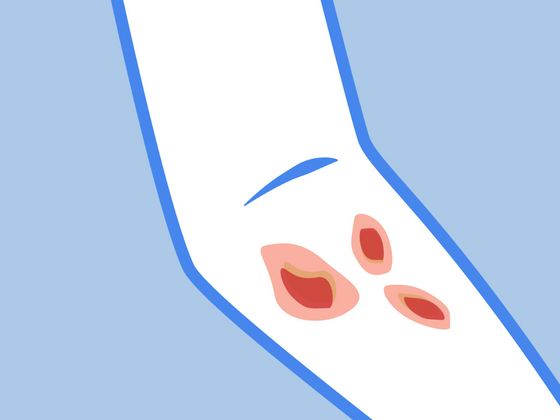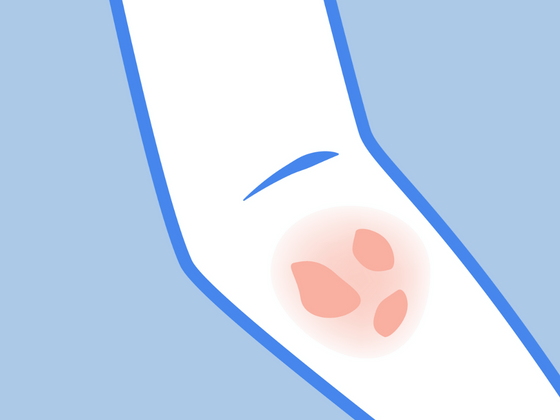The Best Spongiotic Dermatitis Treatment
Is your skin red, itchy, and cracked? You might be dealing with chronic spongiotic dermatitis, a form of eczema that involves fluid buildup in the skin. It can appear anywhere on the body and is often linked to allergies. In this post, we’ll cover the causes, symptoms, and natural treatments for spongiotic dermatitis—so you can start managing it more effectively.
A healthcare provider may perform a skin biopsy to confirm the diagnosis by examining a small tissue sample under a microscope to identify characteristics such as fluid buildup and spongiosis.
Please remember that although we discuss ways to relieve eczema in this post, we are not medical professionals. Therefore, it is best to seek medical advice immediately if you’re experiencing severe eczema symptoms like an infection.
What Is Spongiotic Dermatitis?
Spongiotic dermatitis is an inflammatory skin condition characterized by a buildup of fluid between skin cells, creating a spongy appearance under the microscope. While it’s not a standalone diagnosis, it’s a spongiotic reaction pattern seen in various skin conditions, including atopic dermatitis, contact dermatitis, and dyshidrotic eczema.
This condition often leads to inflamed skin, scaly patches, and severe itching, especially in affected areas like the inner elbows, hands, or feet. Chronic spongiotic dermatitis may also involve thickened skin lesions and persistent irritation.
Symptoms of Spongiotic Dermatitis
Common spongiotic dermatitis symptoms include:
-
Red, itchy, or cracked skin
-
Small, fluid-filled blisters
-
Dry skin and flaking
-
Skin inflammation and tenderness
-
A burning sensation in affected skin
Symptoms vary depending on whether you’re experiencing an acute phase, subacute spongiotic dermatitis, or chronic cases. In acute eczema, blisters and oozing are more likely, while chronic spongiotic dermatitis typically presents with thickened, dry patches.
What Causes Spongiotic Dermatitis?
A number of triggers and risk factors contribute to developing spongiotic dermatitis. These include:
-
Allergic reactions (e.g., to poison ivy or nickel)
-
Irritating substances (soaps, detergents)
-
Food allergies and certain foods
-
Dust mites and other environmental factors
-
Emotional stress
-
Genetic predisposition or family history
-
Underlying autoimmune diseases or systemic diseases
Allergic contact dermatitis is a common cause, as is atopic dermatitis, particularly in people with a history of allergic rhinitis or asthma.
Foods That May Trigger Spongiotic Dermatitis
Some individuals notice skin reactions or flare ups after consuming certain foods, particularly those linked to food allergies. Common culprits include:
-
Dairy
-
Eggs
-
Nuts
-
Soy
-
Gluten
-
Shellfish
If you suspect spongiotic dermatitis foods are contributing to your condition, consider working with a dietitian or allergist to identify potential sensitivities.
How Is Spongiotic Dermatitis Diagnosed?
To diagnose spongiotic dermatitis, a healthcare professional will assess your symptoms and medical history. In some cases, a skin biopsy is required for an accurate diagnosis. This involves removing a small piece of skin surface tissue to examine for signs of spongiosis and inflammation.
Identifying the underlying cause is critical for creating an effective treatment plan.
The Best Spongiotic Dermatitis Treatment
The most effective treatment for spongiotic dermatitis combines medical care, lifestyle adjustments, and skin-friendly products. Because this condition involves inflammation, fluid buildup, and itching, your goal is to soothe the skin, repair its barrier, and avoid flare-up triggers.
Here are some of the best treatments and products to consider:
Use Gentle, Hydrating Moisturizers
Hydration is key to calming itchy, cracked skin. One deeply nourishing option is beef tallow cream. Sourced from grass-fed and finished cows, it’s ideal for those following a Paleo or GAPS lifestyle and is rich in skin-friendly nutrients. This balm helps reduce dryness and inflammation naturally.
Cleanse Gently with Natural Soaps
Conventional soaps and shower gels often contain harsh fragrances, dyes, and preservatives that can irritate sensitive skin and worsen spongiotic dermatitis. To avoid further inflammation, it's best to choose gentle, natural alternatives like eczema soap. One excellent option is the Soap for Eczema with Chinese Herbs, a fragrance-free bar enriched with traditional herbal ingredients. It’s gentle enough for both the body and scalp, making it suitable for conditions like dandruff, cradle cap, and seborrheic dermatitis.
Use Wet Wrap Therapy for Flare-Ups
Wet wrap therapy is a powerful technique to soothe inflamed skin and enhance the absorption of topical treatments. It involves layering moisture and medication beneath damp fabric to boost hydration. Topical corticosteroids can be applied as part of this therapy to help reduce inflammation, but for ongoing care, we recommend prioritizing natural, soothing options like natural creams to maintain the skin’s moisture balance.
Here’s how to do it:
-
Take a lukewarm bath (avoid hot water, which can worsen irritation).
-
Apply a natural moisturizer like eczema cream or the tallow balm mentioned above.
-
Cover the affected area with a Remedywear™ Sleeve or other wet cotton garment.
-
Add a dry layer on top and leave the wraps on overnight or for at least 2 hours.
-
After removing the wraps, reapply moisturizer.
This therapy is especially effective for acute flares and helps break the itch-scratch cycle.
Avoid Common Irritants and Allergens
Managing spongiotic dermatitis means identifying what triggers your flare-ups. This may include:
-
Fragranced products
-
Nickel, latex, or other allergens
-
Certain foods (especially if allergic or sensitive)
Patch testing through a dermatologist can help determine if contact dermatitis is contributing to your symptoms.
Natural Ways to Relieve Symptoms
In addition to prescribed treatment, these self-care strategies may help relieve symptoms:
-
Use hypoallergenic, fragrance-free products
-
Wear breathable clothing over affected areas
-
Apply cold compresses to soothe inflamed skin
-
Limit hot showers and use lukewarm water
-
Manage stress through mindfulness or therapy








